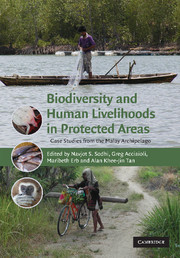Book contents
- Frontmatter
- Contents
- List of contributors
- Acknowledgements
- 1 General introduction
- Part I Conservation needs and priorities
- Part II Conservation with and against people(s)
- Part III Legal and governance frameworks for conservation
- 23 Introduction to Part III
- 24 Protected-area management in Indonesia and Malaysia: the challenge of divided competences between centre and periphery
- 25 Protecting sovereignty versus protecting parks: Malaysia's federal system and incentives against the creation of a truly national park system
- 26 What protects the protected areas? Decentralization in Indonesia, the challenges facing its terrestrial and marine national parks and the rise of regional protected areas
- 27 Learning from King Canute: policy approaches to biodiversity conservation, lessons from the Leuser Ecosystem
- 28 Conclusion to Part III
- 29 General conclusion
- Index
- References
27 - Learning from King Canute: policy approaches to biodiversity conservation, lessons from the Leuser Ecosystem
from Part III - Legal and governance frameworks for conservation
Published online by Cambridge University Press: 12 November 2009
- Frontmatter
- Contents
- List of contributors
- Acknowledgements
- 1 General introduction
- Part I Conservation needs and priorities
- Part II Conservation with and against people(s)
- Part III Legal and governance frameworks for conservation
- 23 Introduction to Part III
- 24 Protected-area management in Indonesia and Malaysia: the challenge of divided competences between centre and periphery
- 25 Protecting sovereignty versus protecting parks: Malaysia's federal system and incentives against the creation of a truly national park system
- 26 What protects the protected areas? Decentralization in Indonesia, the challenges facing its terrestrial and marine national parks and the rise of regional protected areas
- 27 Learning from King Canute: policy approaches to biodiversity conservation, lessons from the Leuser Ecosystem
- 28 Conclusion to Part III
- 29 General conclusion
- Index
- References
Summary
‘I notice the tide is coming in. Do you think it will stop if I give the command?’
His officers were puzzled, but they did not dare say no. ‘Give the order, O great king, and it will obey,’ one of them assured him.
‘Very well. Sea,’ cried Canute, ‘I command you to come no further! Waves, stop your rolling! Surf, stop your pounding! Do not dare touch my feet!’
He waited a moment, quietly, and a tiny wave rushed up the sand and lapped at his feet.
(‘King Canute on the Seashore’ by James Baldwin.)Introduction
In the early 1990s, BAPPENAS, the Indonesian National Development Planning Agency recognized that Indonesia's biodiversity is ‘the country's greatest natural resource’ (BAPPENAS 1993:3). In recognition of the significance of the issue, and in response to the international attention focused on it, during this period, Indonesian policy makers strengthened the country's legislative and policy framework to slow down the loss of primary forests and maintain biodiversity. In 1992, Indonesia joined 163 countries and ratified the Convention on Biodiversity. Yet, Indonesia continues to lose its biodiversity at an alarming rate.
This chapter will consider the outcomes of state policy aiming to conserve Indonesia's biodiversity during the 1990s. At this time, Indonesian policy makers moved away from primarily relying on authority tools and direct government action to achieve biodiversity policy aims, including in national parks.
- Type
- Chapter
- Information
- Biodiversity and Human Livelihoods in Protected AreasCase Studies from the Malay Archipelago, pp. 429 - 456Publisher: Cambridge University PressPrint publication year: 2007

